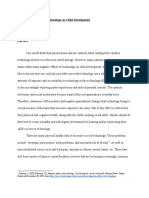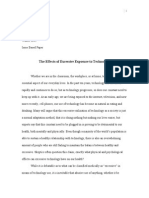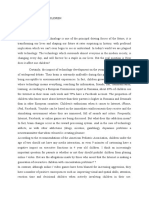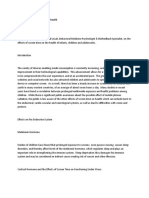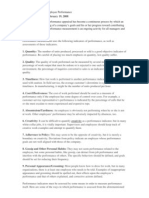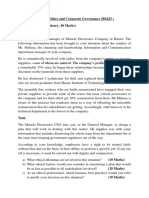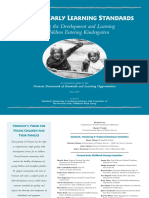Surname 1
Student Name
Professor
Course
25 May 2020
Heavy Use of Technology in Children is Bad for Them
There is a growing body of evidence which proves that not all effects of technology use in
children is positive. Broadly categorized into brain/cognitive and health-behavior effects, there
is a wide array of negative impacts of too much interaction with various technologies like the
Internet, smartphones, personal computers, video games, social media, television, among many
other types of modern technologies. Negative effects range from addiction, sleep disruption,
poor social skills, inability to stay focused on one particular task, emotional and psychological
problems, depression, and many other issues associated with too much screen time among
children and adolescents. The aim of this essay is to highlight some of the most common
negative effects of technology on children so as to encourage appropriate discourse among
stakeholders to come up with effective policy and behavior interventions.
The first major negative impact of heavy use of ICT is the ability to significantly alter the neural
circuitry in the brain of children . Scientists have long established that the brain of children
below 10 years is still developing, with millions of new connections established every second. It
has also been determined that these neural networks are created and reinforced via repeated
mental tasks, with far-reaching implications for learning and memory in children. This has
� Surname 2
contributed to the creation of the concept of experience-dependent change or brain plastici.
Brain plasticity means that our brains are continuously transformed by our routine experiences,
and childhood is a time with characteristically very high brain plasticity. "The developing brain
is more malleable in response to experience than is the adult brain" (Bavelier et al., 2010, p.
692). Heavy use of technology has been shown to have a direct relationship with temporal
changes like mood changes and arousal as well as longer term changes in brain structure and
behavior. 'Current research indicates that children may be wired, but also as a result they may
also be more violent, addicted, and distracted" ( (Bavelier et al., 2010, p. 696). Granted that
available evidence firmly supports the hypothesis that technology use can lead to brain
plasticity in children, this rewiring has also been associated with increased aggressiveness,
addiction, and distraction.
The entertainment industry is full of technologies which purport to provide constant recreation
for people of all age groups, but the sector is driven by what sales quickly rather than improving
the lives of technology consumers. Aggression or Violence is one of the most studied and
documented negative effects of technology. The potential for media to induce violent conduct
and behavioral aggression is arguably one of the biggest concerns about the influence of
technology among children and the general public (Bavelier et al., 2010, p. 698). Children are
constantly exposed to violent media content, be it through action video games or television
shows, with Baveller and colleagues observe that in 1997 more than 60% of television shows
featured violent behaviors and that 94% of video games rated as child friendly had some
instances of violent conduct. The researchers note that young children acquire beliefs about
what are socially acceptable behaviors and social norms from the details of their daily
� Surname 3
experiences, and any activity that appears to encourage violence increases the chances of that
child developing violent tendencies later in life. So, violence scenes in media work alongside
other predispositing factors of aggressive conduct such as substance abuse, poor academic
performance, and abusive family backgrounds to increase the risk of children developing
aggressive behavior in adulthood. Repeated media portrayal of violent behaviors serves to
normalize such conduct in young children who actively model their behavior and worldviews
from their experiences, whether such experiences are in real life or come from virtual worlds
and realities.
Addiction is a big issue when it comes to the topic of technology and young children. While
experts are reluctant to classify compulsive internet use and video gaming as mental health
issues, there is currently an emerging consensus among scientists regarding the potential of
excessive video gaming and internet use to become a pathological problem because these
activities can severely limit an individual's ability to function normally in the society. Research
evidence has documented how social media usage and video gaming has the ability to stimulate
the same brain centres that are in control of pleasure and excitement. The adrenaline rush that
video gamers receive from a challenging milestone or competitiion against other online users
can shut off all other regions of the brain, making a person to play for many hours without a
break. This is the same case with being angeged in online chatrooms and social media. The net
effect of these compulsive behaviors are diminished social interactions, limited Physical activity,
poor eating habits, chronic absenteeism from work or school, and many other problems as
virtual worlds take up much of an individual's time. "Entertainment technology (TV, Internet,
video games, iPads, cell phones) has advanced so rapidly, that families have scarcely noticed
� Surname 4
the significant impact and changes to their family structure and lifestyles" (Rowan, 2017, para
2). The overall effect of these various entertainment technologies is the absence of touch and
face to face interactions, important factors that are important in child development. Social
media and video game addiction have significant social, physical, and psychological problems.
Many young children today are spending a lot of time online, and this leaves them little time to
hold face to face conversations with their families and friends. The result is a general lack of
important social skills and emotional intelligence, leading to people who are socially awkward
and emotionally flat. In addition, excessive video gaming and online presence leads to eating
disorders such as excessive consumption of unhealthy foods as users have no time to attend to
their basix necessities like eating and personal hygiene. Heavy use of technology has been
associated with weight issues like obesity due to extended periods of inactivity as social media
users and video gamers sit in front of their screens for long periods of time.
There are many health problems that emanate from technology use among people of all age
groups. The first health problem directly resulting from heavy use of technology is sleep
disruption. The use of various technological devices such as as computers, tablets, and
smartphones at night has been linked to problems of falling and staying asleep because these
gadgets emit plenty of blue light. A link has been identified between the use of these light
emitting devices in the evening and diminished production of melatonin, a very important
neurochemical that helps us to fall asleep quickly. Young children are particularly sensitive to
blue light than older people. Spending time in front of screens interferes with the natural sleep
cycle, leading to insomnia and chronic fatigue. Recent studies have linked extended use of
digital screens such as computers and television to obesity in children. This happens when
� Surname 5
people eat while also watching TV or playing video games, activities which might delay their
feelings of satiation because the users are usually distracted. People interacting and
entertainment technologies also have very limited physical activity due to the nature of these
recreational activities, limiting their opportunities for burning excess calories through exercises.
Muscle and skeletol injuries are also common effects of technology use among children and
adults alike. Staying online or video gaming for long hours requires that people assume certain
body postures for extended periods of time. This rigid sitting postures, coupled with limited
physical activity, leads to issues of postural and musculoskeletal strains and discomforts such as
back and kneck pains, writ injuries, among other problems associated with prolonged
immobility.
Conclusion
As Clinton and James, 2017 put it, "We need legislation, educational efforts and norms that
reflect 21st-century realities to maximize the opportunities and minimize the risks for our
kids"while we can't deny the many benefits and conveniences brought about by advances in
modern technology, parents, teachers, and policy makers need to start a conversation about
the potential detrimental effects of unregulated technology use among society's most valued
demographic, its young children. Entertainment companies need to be closely regulated to
ensure that their commercial interestes do not overshadow safety and privacy considerations,
especially for young children and adolescents. Parents and teachers need to step up efforts to
educate their children on the negative effects of heavy use of entertainment technologies such
as sleeping problems, eating disorders, mental health issues, lack of social interactions, mood
� Surname 6
swings, violence, addiction, among other problems associated with the use of technology
among children.
Works Cited
� Surname 7
Bavelier, Daphne, C. Shawn Green, and Matthew WG Dye. "Children, wired: For better and for
worse." Neuron 67.5 (2010): 692-701.
Clinton, Chelsea, and James P. Steyer. “Is the Internet Hurting Children?” CNN, Cable News
Network, 21 May 2012,
edition.cnn.com/2012/05/21/opinion/clinton-steyer-internet-kids/index.html.
Rowan, Cris. “The Impact of Technology on the Developing Child.” HuffPost, HuffPost, 7 Dec.
2017, www.huffpost.com/entry/technology-children-negative-impact_b_3343245?
guccounter=1&guce_referrer=aHR0cHM6Ly93d3cuZ29vZ2xlLmNvbS9zZWFyY2g_Y2xpZW50PW
ZpcmVmb3gtYi1tJnE9JUUyJTgwJTlDVGhlK0ltcGFjdCtvZitUZWNobm9sb2d5K29uK3RoZStEZXZlbG
9waW5nK0NoaWxkJUUyJTgwJTlEKyZvcT0lRTIlODAlOUNUaGUrSW1wYWN0K29mK1RlY2hub2xv
Z3krb24rdGhlK0RldmVsb3BpbmcrQ2hpbGQlRTIlODAlOUQrJmFxcz1oZWlybG9vbS1zcnAuLjBsM
w&guce_referrer_sig=AQAAAG__TjOW09I3iuEINX1QEvaLYAMgqYDOuiprE7lsVA25mNR_6P11gy
NtK7oas0wc8SHezs8K0McBQlixbCp0Pwnxfuchg1abHD2rafi6o-
RTdEDoXl5Izl9k6Ak41ZsVqgG2sfazep3Z8nx_9v7AEy6S32ydr7FISo3QHdx9utvO.



